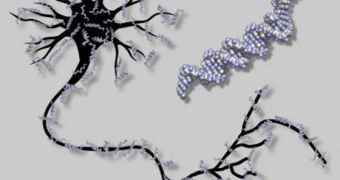A group of scientists from the California Institute of Technology (Caltech) announces the development of the first synthetic neural network made out of deoxyribonucleic acid (DNA). The accomplishment brings the goal of creating true artificial intelligence one step closer to reality.
Many experts have tried doing so in a variety of ways, most often on computer chips and in robots. But this is the first time that a neural network is grown in a test tube. Remarkably, the artificial construct can use incomplete patterns to recall memories, which is how the human brain does this.
Each of the four artificial neurons in the network is constructed out of 112 DNA strands. The nerve cells work together to find answers to questions scientists ask of the network. The structure is capable of playing a mind-reading game.
It has been trained to recognize four of the scientists in the Caltech team. Each of the experts is represented through a specific combination of DNA strands, and is identified by a specific succession of answers to a set of four questions.
When the neural network is given an incomplete set of answers, it can still extrapolate the identity of the scientist in question. If it cannot, it alerts the team to the fact that it has insufficient data. This is done via fluorescent signals.
The construct is therefore capable of an uniquely-human trait, which is to remember something based on incomplete cues. Determining the meaning behind scarce patterns is one of the things that allowed us to survive for so long.
“What we are good at is recognizing things. We can recognize things based on looking only at a subset of features,” says the Caltech Gordon and Betty Moore professor of computation and neural systems and electrical engineering Jehoshua Bruck, also a coauthor of the new study.
Details of the work appear in the July 21 issue of the top scientific journal Nature. Caltech senior postdoctoral scholar in bioengineering Lulu Qian was the lead author of the new paper, entitled “Neural network computation with DNA strand displacement cascades.”
“The brain is incredible. It allows us to recognize patterns of events, form memories, make decisions, and take actions. So we asked, instead of having a physically connected network of neural cells, can a soup of interacting molecules exhibit brainlike behavior?” Qian says, adding that the answer is yes.
The biochemical system developed at Caltech is still a proof-of-concept model, but the team is convinced that it will be able to refine on the existing model in the future. This could allow the network to become capable of solving more complex problems, PhysOrg reports.
“Our paper can be interpreted as a simple demonstration of neural-computing principles at the molecular and intracellular levels. One possible interpretation is that perhaps these principles are universal in biological information processing,” Bruck concludes.

 14 DAY TRIAL //
14 DAY TRIAL //